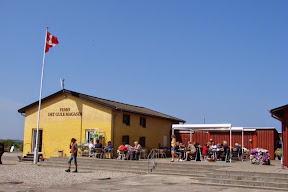We currently are in Bøgeskov. This is a very nice small harbour in the middle of nowhere, and there is no Internet connection at all, neither WiFi or 3G. Even a slow connection fails and we can't send SMS's, unheard of in Denmark.
So I am writing a blogpost, to be posted tomorrow from a bigger harbour.
After a very rainy and windy day in Rødvig yesterday, our trip today took us past Stevn's Klint. This is very interesting from a geological and historical point of view.
The 'Klint' or 'cliff' consist of two 'layers', the lower ons being soft chalk and the upper one relatively hard limestone. Each of those layers was formed by microscopic sea creatures. But obviously by different creatures. Over 66 million years ago, these creatures produced the soft chalk, but 66 million years ago there was a catastrophic change and the creatures that lived after that time produced the much harder limestone.
What was this catastrophic event?
The theory is that 66 million years ago, the earth was hit by a meteorite, which caused an enormous ash cloud all around the globe. This ash cloud stopped the solar rays from reaching the earth, which caused many plants to become extinct. As a result, many animals also perished, amongst which the dinosaurs, but also the sea creatures that produced the chalk. Once the ash cloud settled on the land, other forms of life took over, amongst which the ones (bryozoans) producing the limestone. In between the chalk layer and the limestone layer is a thin black line: the ash from the meteorite impact. It is called the 'fish clay' and is rich in Iridium, an element that is rare on earth but commonly found in meteorites which supports the above theory.
As the lower chalk layer is much softer than the upper limestone layer, the bottom is eroded from under the top as can clearly be seen in this picture taken from the sea this morning:

It is not surprising that from time to time, the top bit breaks off and falls into the sea. In 1928 this happened to a place where an old church stood and part of the church, the choir, fell into the sea. The remainder has since been strengthened so it won't fall too!

Historically, 'inside' the Klint there used to be a defensive base from the days of the 'Cold War'. The area can control the shipping traffic through the Sund, the waterway between Denmark and Sweden which the Russian ships would have to use to get from the Baltic ports into the North Sea. This fort is now a museum.
Once we got to Bøgeskov, we took a walk through the forest.


Tomorrow we'll go to Ishøj, a port just South of Copenhagen which will be our base for visiting the capital.




















































